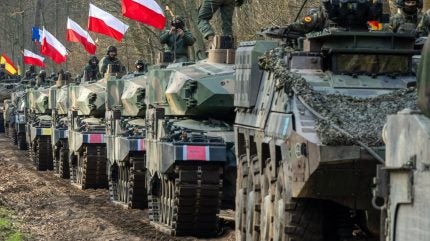
The US State Department has injected a further $4bn of Foreign Military Financing (FMF) in Poland, which brings the country’s loans and loan guarantees to more than $11bn (44.44bn zlotys) in the last two years.
Trans-Atlantic relations have taken a positive turn since Russia’s invasion of Ukraine (nearly) three years ago. It is largely modelled on a historical trend in which the US props up Europe’s military build-up in times of global insecurity.

Discover B2B Marketing That Performs
Combine business intelligence and editorial excellence to reach engaged professionals across 36 leading media platforms.
GlobalData observed that Poland’s “position as a leader within Nato and Europe” according to its ‘Poland Defence Market, 2024-2029’ report, hinges on the country’s rapid military modernisation and spending commitment, all backed by US financial support.
Other European members of Nato, however, continue to drag their heels. The UK for example has no plan to commit as little as 2.5% of its GDP on defence, while Poland boasts 4% going on 5%.
This is concerning as the Nato spirit is heading for a low, once again, with the return of the protectionist former President Donald Trump to the White House. This will leave Europe to fend for itself against Russia, and for US funds to run dry.
Alternative defence supply
In this backdrop, it may be that the US defence market will get the cold shoulder from allies and partners in Europe over the next four years.

US Tariffs are shifting - will you react or anticipate?
Don’t let policy changes catch you off guard. Stay proactive with real-time data and expert analysis.
By GlobalDataCrucially, FMF provides a grant or loan assistance for the acquisition of US defence articles, services, and training which supports the US economy and promotes its national security.
Without this mode of mutual support, Europe will begin to expand its own collective defence industry, which it is trying to do already, and look to other global suppliers, such as South Korea.
Poland is currently buying US systems such as Apache helicopters, the Airspace and Surface Radar Reconnaissance System, High Mobility Artillery Rocket Systems (HIMARS), and Patriot air and missile defence systems.
However, South Korea has also begun to cultivate a solid footing in Poland during the past two years. Since 2022, contracts for K2 tanks, K9 howitzers and FA-50 combat aircraft were signed, as the country positions itself as one of the most important and largest Polish defence suppliers.
In June, the Polish Ministry of National Defence revealed that it is preparing to produce K2 tanks inside Poland. This decision will bring a manufacturing facility for Korean platforms in Europe, securing a base for further exportability to Poland’s allies.
The UK similarly considered the K9 artillery system until the government neglected its competition-based approach in May. Now, it has selected the German arms manufacturer, Rheinmetall, to help produce RCH-155 systems earlier this year.





